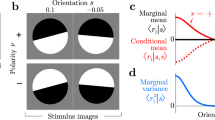Abstract
The principles of information coding by “rings” of stochastic dependence, formed by neuron populations, are described. Such a population was shown to be capable of existing only in strictly definite stochastic states, determined by a certain number of “rings” of stochastic dependence, A system consisting of a fixed number of neurons was shown to be able to code and transmit a number of different messages equal to the square of the number of stochastic states permitted for that system. The number of messages differing from each other either in the number of letters or their order in the word was equal to the number of permitted stochastic states, whereas the number of messages containing the same number of letters in the word was equal to the difference between the number of permitted stochastic states and the number of neurons in the system. The alphabet consists of two letters: A for assembling of the ring of stochastic dependence, and B for breaking of this ring, together with punctuation signs indicating neither assembling nor breaking (compared with the initial state) of stochastic dependence rings.
Similar content being viewed by others
Literature cited
N. P. Bekhtereva, P. V. Bundzen, V. D. Kaidel, and é. é. David, “Principles of organization of the structure of the spatiotemporal code of short-term verbal memory,” Fiziol. Zh. SSSR,59, No. 11, 1785 (1973).
S. I. Kovbasa, “Assessment of interdependence of spike trains in neuronal systems,” Biofizika,25, No. 6, 1086 (1980).
S. I. Kovbasa, “Coding of information sources by ratio of stochastic dependence of spike discharges of groups of neurons,” in: Engineering Problems in Medicine [in Russian], Tomsk (1983), pp. 81–82.
S. I. Kovbasa, S. V. Yagodin, and A. D. Nozdrachev, “Quantitative evaluation of matching of the spike trains of a functional group of neurons,” Fiziol. Zh. SSSR,69, No. 12, 1644 (1983).
A. B. Kogan, “Neuronal groups as elements in the construction of a neural center,” in: Mechanisms of Combination of Neurons in a Neural Center [in Russian], Kiev (1972), pp. 21–26.
G. Edelman and V. B. Mountcastle, The Mindful Brain, MIT Press, Cambridge, Massachusetts (1978).
A. D. Nozdrachev, S. I. Kovbasa, and S. V. Yagodin, “Quantitative evaluation of interference between action potentials in combined electroneurograms,” Fiziol. Zh. SSSR,68, No. 10, 1454 (1982).
A. N. Radchenko, Models of the Principal Mechanisms of the Brain [in Russian], Nauka, Leningrad (1968).
E. N. Sokolov, Neuronal Mechanisms of Memory and Learning [in Russian], Nauka, Moscow (1981).
G. Somjen, Sensory Coding in the Mammalian Nervous System, Plenum Press (1975).
R. L. Stratonovich, Information Theory [in Russian], Sov. Radio, Moscow (1975).
M. I. Shtokman, “On a correlation-optical method of studying interaction between neurons in nerve networks,” Preprint No. 96, Novosibirsk (1979).
H. T. Chang. “The repetitive discharges of corticothalamic reverberating circuits,” J. Neurophysiol.,13, No. 3, 235 (1950).
W. Freeman, “Linear analysis of the dynamics of neural masses,” Ann. Rev. Biophys. Bioeng.,1, 225 (1972).
A. Grinvald, L. B. Cohen, S. Lesher, and M. B. Boyle, “Simultaneous optical monitoring of activity of many neurons in invertebrate ganglia using a 124-element photodiode array,” J. Neurophysiol.,45, 829 (1981).
R. J. MacGregor and C. A. Radeliffe, “A random walk model for reverberatory pathways in reticularlike networks,” Brain Res.,63, 374 (1973).
D. H. Perkel, G. L. Gerstein, M. S. Smith, and W. G. Tatton, “Nerve-impulse patterns: a quantitative display technique for three neurons,” Brain Res.,100, 271 (1975).
R. B. Stein, K. V. Leung, M. N. Oguztöreli, and D. W. Williams, “Properties of small neural networks,” Kybernetik,14, 223 (1974).
H. R. Wilson and J. D. Cowan, “A mathematical theory of the functional dynamics of cortical and thalamic nervous tissue,” Kybernetik,13, 55 (1973).
Author information
Authors and Affiliations
Additional information
Translated from Fiziologicheskii Zhurnal SSSR imeni I. M. Sechenova, Vol. 70, No. 4, pp. 492–500, April, 1984.
Rights and permissions
About this article
Cite this article
Kovbasa, S.I., Nozdrachev, A.D. & Yagodin, S.V. Principles of signal coding by the discharge pattern of a neuron population. Neurosci Behav Physiol 16, 314–321 (1986). https://doi.org/10.1007/BF01148175
Received:
Issue Date:
DOI: https://doi.org/10.1007/BF01148175




